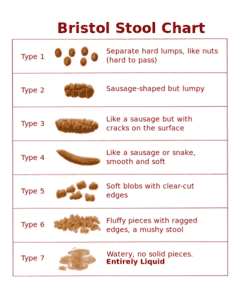It can take on average between 12 and 72 hours for food to travel from the beginning of the digestive system to the end. This is called bowel transit time. Ideally, bowel movements occur daily, with an optimal transit time of between 18 and 24 hours. Too short a transit time can result in diarrhea and nutrient malabsorption, while too long a bowel transit time can result in constipation.
The length of transit time can depend on many different factors: types of foods consumed (including plant-based fibrous foods or sugars and sugar substitutes), stress management, physical activity; microbial overgrowths, food allergies/sensitivities/intolerances, antibiotic use, excessive magnesium or vitamin C intake, nutrient deficiencies, gallbladder issues, hypothyroid, and potency of digestive secretions. Your transit time may vary by day, week, or month depending on circumstances.
A fast transit time, 12 hours or less, may suggest diarrhea and nutrient malabsorption issues. However, an easily digestible and absorbable diet consisting only of fruits, vegetables, and water could also contribute to a quicker transit time.
A slow transit time, more than 30 hours, may suggest wastes and toxins remain in the body for too long and may be reabsorbed back into the bloodstream.
When doing a bowel transit time test, also note the color, texture, odor, and size of your stool, and if any undigested food outside of the marker exists. These may all be clues as to what is impacting transit time.
How to Perform a Bowel Transit Time Test
- Choose a “marker” to track – something you will ingest that you will be able to see in the stool. Choose from: two red beets, 4 charcoal capsules, 2 Tbsp (30 ml) liquid chlorophyll, 2 Tbsp (20 g) poorly chewed corn kernels, or 2 Tbsp (20 g) white sesame seeds.
- On day 1, right after your first bowel movement, ingest your marker.
- Complete the attached form, which includes the time you ate the marker and a log of what you ate, your daily activity, and your stress levels.
- At your next bowel movements, check for the marker. Write down when it first appears, as well as if it reappears at subsequent bowel movements. The first appearance determines transit time (so if the marker is consumed at 9 am, and there is a bowel movement the next day at 8 am, the transit time may be 23 hours but this needs to be confirmed in step 5). Note if the marker reappears at further bowel movements to track when it has fully passed.
- Retest and tighten the time frame on the next day to ensure accuracy. Wait 4 hours after your first bowel movement and then consume the marker again. Check subsequent bowel movements for the marker. If your bowel movement on retest day is at 9 am and you consume the marker at 1 pm, and on day 2 the marker reappears in your 9 am bowel movement, then the transit time tightens to 20 hours. Allow the marker to fully pass, then repeat again a 3rd time, this time moving the marker ingestion forward again for a total of 6 hours (9 am bowel movement, 3 pm marker ingestion). If the marker does not reappear in the following morning’s bowel movement, then you can assume the transit time was actually closer to 20 hours. If it does reappear, then the transit time is even faster.
Transit Time Detail Record
| 1st marker | 2nd marker | 3rd marker | |
| Marker used | |||
| Time in | |||
| Time first appears | |||
| Time completely clears | |||
| Transit time = (time in – time first appears) | |||
| Diet details (quantity liquids, types of foods, etc) | |||
| Exercise and activity details | |||
| Stress levels, 1-10 (include highest & lowest scores for the day) |







